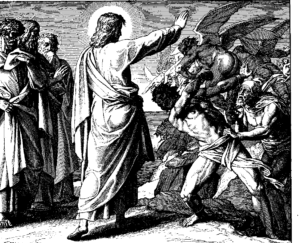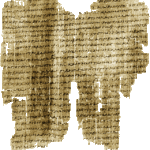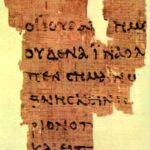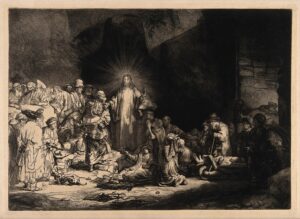Demon’s Recognition of the “Son of God”
Gospel accounts of the supernatural realm of principalities recognizing Jesus of Nazareth as the Son of God occurred in a specific hierarchical sequence. Demons were the last of those in the Gospels who recognized Jesus as the Son of God.
Before Jesus was born, Matthew and Luke accounts report the birth was announced by God through an angel saying that Mary miraculously conceived her baby by the Holy Spirit with Luke reporting he would be the Son of God.[1]
As an adult, God Himself was the first to recognize Jesus as the Son of God. Immediately after Jesus was baptized by John the Baptist, the Voice of God called out: [2]
MK 1:11 “You are My beloved Son, in whom I am well pleased.” (NKJV)
John the Baptist himself testified to what he had seen and heard that day when he baptized Jesus of Nazareth:[3]
John 1:32-34 “I saw the Spirit descending from heaven like a dove, and He remained upon Him. I did not know Him, but He who sent me to baptize with water said to me, ‘Upon whom you see the Spirit descending, and remaining on Him, this is He who baptizes with the Holy Spirit.’ And I have seen and testified that this is the Son of God.” (NKJV)
Fasting for 40 days in the wilderness after his baptism, Satan approached Jesus in his emaciated condition. In the second recognition of Jesus as the Son of God, Satan cunningly began his temptations by saying to Jesus, “If you are the Son of God…” Rebuffing the temptations, Jesus quoted from the Scriptures.
Beginning his public ministry, Jesus traveled from Nazareth to a Capernaum where he taught in a synagogue. A man in the audience was possessed by an “unclean demon” and its voice cried out: [4]
LK 4:34 “Let us alone! What business do we have with each other, Jesus of Nazareth? Have You come to destroy us? I know who You are — the Holy One of God!” (NKJV)
Paying close attention to the pronouns using the word “us,” the demon spoke on behalf of other demons, then spoke for himself. Commanded to be silent and to come out of the man, the demons threw the possessed man down with convulsions before leaving him unharmed. Those who witnessed the exorcism were “amazed” exclaiming Jesus was someone of authority and power making his fame to spread quickly.[5]
It would not be the only instance when demons proclaimed Jesus to be the Son of God. Mark and Luke wrote that whenever demons saw Jesus, they forced their hosts to fall down before him crying out, “You are the Son of God.”[6]

Matthew, Mark and Luke record another especially harrowing encounter with demons in the Gerasenes (Gararenes) region.[7] The incident occurred after the miracle of calming the storm during a journey across the Sea of Tiberius (Galilee) to the Gentile side in present-day Syria.
Living naked among the tombs, restraints on the possessed man were useless – chains and shackles would only be broken into pieces. Out of fear, people obviously avoided the area of the tombs.
Mark and Luke accounts say there was just one possessed man while Matthew’s Gospel says there were two. Differences do not mean there was not a second demon-possessed man.
Mark and Luke based their accounts on witnesses’ memories telling of one specifically, most frightening possessed man while Matthew, who very well have been present, said there were two possessed men. All three Gospels speak of multiple demons.[8]
Arriving on shore, the head demon spotted Jesus and forced its host to run and bow down before him. A voice of one demon cried out asking for mercy:
MK 5:7 “What have I to do with You, Jesus, Son of the Most High God? I implore You by God that You do not torment me.” (NKJV)
Asked for his name by Jesus, the demon-voice answered said, “My name is Legion, for we are many.”[9] When Jesus commanded the demons to come out, Legion begged Jesus for mercy not to be thrown into the abyss; instead, asking that they would be allowed to enter a nearby herd of swine.[10]
Begging for mercy to the Son of God, the demons recognized that Jesus had complete power and discretion over them. Granting their request, Jesus allowed the demons to enter a herd of pigs which then charged down a steep hill into the sea and drowned.
Herdsmen of the hogs ran into the town and told their story of what had happened. A crowd gathered, went out to see for themselves and found the former fearsome, demon-possessed man clothed and calmly sitting at the feet of Jesus.
Fear gripped the crowd and they implored Jesus to leave them alone. Honoring their request, Jesus told them to return to their homes, then sailed back across the sea.
Meanwhile, the healed man proclaimed throughout the town what Jesus had done for him. Accounts of the exorcisms carried such a degree of credibility, the enemies of Jesus eventually believed the witnesses.
Pharisees became involved and accused Jesus of casting out demons in the name of Beelzebub, another name for Satan.[11] In a response, Jesus asked two rhetorical questions:
LK 11:18-20 “”If Satan also is divided against himself, how will his kingdom stand? Because you say I cast out demons by Beelzebub. And if I cast out demons by Beelzebub, by whom do your sons cast them out? But if I cast out demons with the finger of God, surely the kingdom of God has come upon you.” (NKJV)
The Book of Acts, written by the same author as the Gospel of Luke, recounts another demon encounter, but this one did not end well. Some Jewish exorcists, the seven sons of high priest Sceva, attempted an exorcism.
Invoking the name of Jesus, they said to the demon, “I adjure you by Jesus whom Paul preaches.”[12] Not impressed by their command, the demon retorted, “I know about Jesus and I am acquainted with Paul, but who are you?”[13]
Reaction by the demon forced the possessed man to overpower the seven sons and beat them to a point they ran from the house naked and bleeding. According to the author, word of the incident spread throughout Ephesus causing fear and praise for the name of Jesus.[14]
In the supernatural realm, if God, Satan and his demons recognized Jesus as the Son of God, should mortal people recognize Jesus, too?
Updated May 21, 2024.
This work is licensed under a Creative Commons Attribution-NonCommercial-NoDerivatives 4.0 International License.
REFERENCES:
[1] Luke 1:30-32, 35. CR Matthew 1:20-22.
[2] Mark 1:11. Luke 3:21-2. NKJV. CR Matthew 3:13-17; Luke 4:16-28; John 1:32-33.
[3] NKJV.
[4] Luke 4:34. NASB. CR Mark 1:24.
[5] Mark 1:27-28; Luke 4:36-37.
[6] Mark 3:11; 9:17-27; Luke 4:41, 6:18. NKJV.
[7] Matthew 8:29-34; Mark 5:1-13; Luke 8:26-39.
[8] Matthew 8:28. NetBible.org. Footnote 1. Kant, Garth. WND. “How skeptic turned demon hunter.” photo. 2016. <https://www.wnd.com/2016/08/all-american-girl-turns-skeptic-into-demon-hunter>
Matthew 8:28. BibleHub. “Commentary.” n.d. <https://biblehub.com/commentaries/matthew/8-28.htm>
[9] Mark 5:9. NET.
[10] Luke 8:29-33.
[11] Matthew 9:34; 12:22-24; Mark 3:20-30;. Luke 11:14-23.
[12] Acts 19:13. NET. Acts 19:13-17.
[13] Acts 19:15. NET.
[14] Acts 19:13-17.



